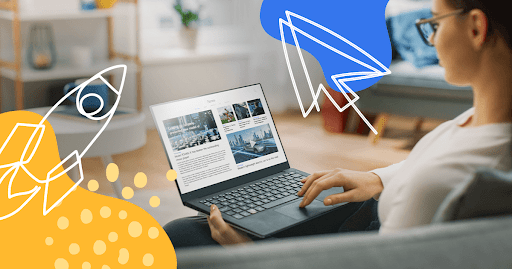Mar 06, 2025
Local SEO for Small Business: Stand Out Where It Matters Most

When someone nearby searches for a service or product you offer, does your business show up?
If the answer is no—or not often enough—you’re missing out on your most valuable audience: local customers ready to take action.
That’s where local SEO for small business comes in. It’s the strategy that helps small businesses appear in local search results, drive in-store visits, phone calls, and online leads from nearby potential customers.
This guide breaks down exactly how you can use local SEO to grow your small business and stay ahead of local competitors.
What Is Local SEO and Why Should You Care?
Local SEO, or local search engine optimization, is the process of optimizing your online presence so that your business shows up in location-based search results. Think of phrases like:
- “Bakery near me”
- “Dentist in [your city]”
- “Digital agency in [location]”
These are searches with clear local intent—and Google prioritizes businesses that have taken steps to prove their relevance in the area.
Unlike traditional SEO, which targets national or global audiences, local SEO focuses on being visible in your own community. For small businesses, this often means the difference between being found or being forgotten.
Optimize Your Google Business Profile First
The most powerful free tool for local SEO is your Google Business Profile (formerly Google My Business). This is what shows up on Google Maps and in the local pack—the section with business listings, ratings, and directions.
Here’s how to optimize it properly:
- Fill out every section, including business name, address, phone number, website, and business hours.
- Use accurate and consistent contact details across all platforms.
- Add a compelling business description using keywords related to your services and location.
- Upload high-quality images of your storefront, products, team, or service area.
- Post updates regularly to keep your profile active and engaging.
- Encourage satisfied customers to leave positive reviews and respond to them professionally.
An optimized Google Business Profile increases your chances of appearing in local search results and builds trust with customers before they even visit your site or store.
Use the Right Local Keywords
Think about what your customers are searching for. What questions are they asking? What locations are they using?
Start by identifying keywords that include your service and your location. These could be:
- “Hair salon in [neighborhood]”
- “Emergency plumber [city name]”
- “Affordable graphic designer in [area]”
Once you have a list, use those keywords naturally in your:
- Page titles and headings
- Meta descriptions
- Website content
- Image alt tags
- Blog posts
Don’t overstuff keywords. Write for your customers first—but make sure search engines understand where you are and what you offer.
Make Your Website Locally Relevant
Google looks at your website to decide how relevant you are for local searches. That means your website needs to clearly show where you're located and what services you provide.
Tips to improve local SEO on your website:
- Mention your city or service area on your homepage and key pages.
- Create dedicated pages for each location if you serve more than one area.
- Add your full business address and phone number in the footer.
- Use testimonials or stories from local customers.
- Include directions or an embedded map on your Contact page.
Make sure your site is fast, mobile-friendly, and easy to navigate. Local customers often visit your website on the go.
Certain industries require a more specialized local approach—and restaurants are a prime example. If you're in the food business, our guide on local SEO for restaurants reveals how to turn nearby searches into real-world diners through smart, location-focused strategies.
Build Local Authority Through Citations
Citations are online mentions of your business’s name, address, and phone number—even if there’s no link.
Submit your business to trusted online directories such as:
- Yelp
- Bing Places
- JustDial
- IndiaMart
- Yellow Pages
- Local business associations
Every time your business is listed correctly in a reputable directory, it sends a positive signal to search engines about your legitimacy.
Keep all listings consistent. If one directory lists your address slightly differently, it can hurt your rankings.
Gather and Manage Customer Reviews
Reviews matter—a lot. They help your business stand out in search results and influence potential customers to choose you.
Encourage happy customers to leave reviews on your Google Business Profile. You can also collect reviews on Facebook, Yelp, or niche-specific platforms.
How to get more reviews:
- Ask in person after a successful interaction.
- Follow up via email or text.
- Make it easy—share a direct link to your review page.
Respond to every review, good or bad. Thank your supporters and address any complaints professionally. Google looks at both your reviews and your responses when ranking businesses.
Create Content That Serves Your Local Audience
You don’t need to blog daily, but creating useful content tailored to your local audience is a powerful way to grow your visibility.
Some ideas:
- Highlight local events your business participates in.
- Write about problems your service solves in your area.
- Share customer stories or local success stories.
- List top places or services in your neighborhood (with your business included).
This kind of content builds authority, increases traffic, and improves your chances of being featured in local search results.
Get Local Backlinks
A backlink is when another website links to yours. Local backlinks show search engines that trusted local sources are vouching for your business.
How to earn them:
- Partner with other local businesses or suppliers.
- Sponsor community events or charity drives.
- Submit guest posts to local blogs or publications.
- Get listed on your chamber of commerce or industry association website.
The more local links you build, the stronger your local presence becomes in Google’s eyes.
Mobile and Voice Optimization Matters
Most local searches happen on mobile devices—and many are voice searches.
Make sure your website is mobile-friendly. That means fast loading, easy-to-read text, clickable phone numbers, and smooth navigation.
For voice search, structure your content to answer common questions clearly. Think “who,” “what,” “where,” and “how” questions that customers ask.
Track Your Local SEO Performance
Once your local SEO strategy is in place, you need to track what’s working.
Key metrics to monitor:
- Views and actions from your Google Business Profile
- Website traffic from local keywords
- Number and quality of customer reviews
- Local rankings for important keywords
- Clicks for directions or phone calls
Use tools like Google Analytics, Search Console, and Google Business Profile Insights. Regular reviews of your data will help you spot what’s working and where to improve.
Avoid Common Local SEO Mistakes
Even with good intentions, it’s easy to fall into traps that hurt your local visibility. Watch out for:
- Inconsistent business information across directories
- Ignoring or delaying responses to reviews
- Neglecting your Google Business Profile
- Copying content from competitors or other locations
- Failing to include your location clearly on your site
- Skipping mobile optimization
Avoiding these mistakes can give your business a clear edge over local competitors.
Final Thoughts: Local SEO Isn’t Optional—It’s Essential
If you’re a small business serving a specific area, local SEO isn’t a nice-to-have—it’s a must-have.
It’s what helps you get discovered by nearby customers. It’s what turns searches into sales. And it’s what ensures your business stays competitive in the area you serve.
From Google Business Profile optimization and local keywords to content creation and customer reviews—every step you take builds your authority, visibility, and trust in your community.
Investing in local SEO is one of the smartest moves a small business can make. It doesn’t just get you traffic. It gets you the right traffic—local, ready-to-buy, and loyal.
Looking to take your local visibility to the next level? At Uprankx, we specialize in building results-driven local SEO strategies for small businesses that want to grow.




